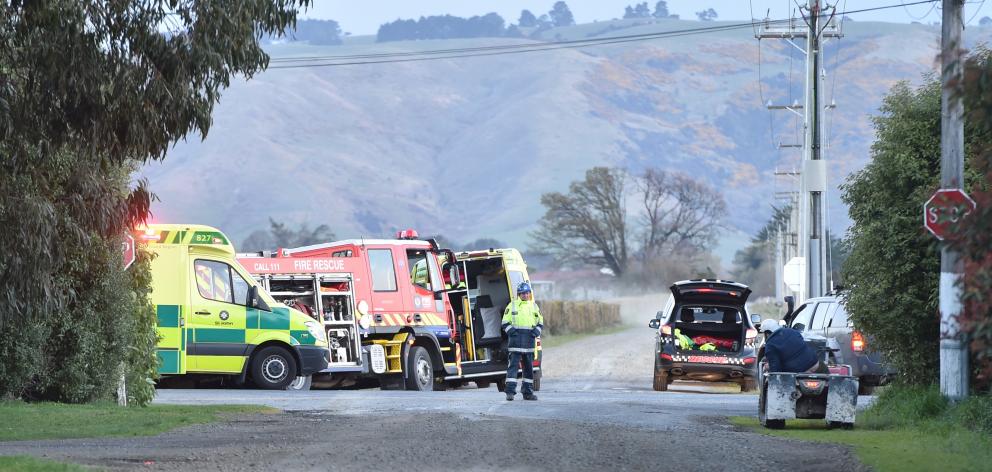
On September 17, 2019, Jayde Amy Cummings, 15, was killed instantly when the driver of the ute she was in travelled along Church Rd West and failed to stop at the intersection with Huntly Rd.
The driver, 17, who was on a restricted licence, collided with a vehicle driven by 57-year-old Stephen Mark Macnee, who also died at the scene.
In a decision released today, coroner Marcus Elliott said there were no marks at the scene to suggest the teen slowed down and therefore it was most likely he was oblivious to the intersection.
He noted the Dunedin City Council could not absolve itself of legal responsibility as the road-controlling authority.

The coroner took aim more squarely at Downer.
The company was contracted by the council for road-network maintenance, was expected to undertake fortnightly inspections of such spots, and was relied upon to identify traffic-safety hazards.
"By failing to identify the presence of the foliage and informing the council, Downer’s inaction contributed to the crash and to the deaths," the coroner said.
Jayde’s father Mark Cummings has long been vocal about the maintenance of the site and said the judgement put "a wee smile" on his face.
He reflected, however, on "four years of hell" and said the legal battles and trauma he had suffered meant he had not yet properly grieved for Jayde.
In 2021, after learning of the teenage driver’s discharge after admitting two charges of careless driving causing the deaths through media reports, rather than the proper channels, Mr Cummings lost control and damaged property at his lawyer’s office.
He was arrested a short time later after smashing a window at the city council’s headquarters.
A manager from Downer apologised at the inquest hearing but it gave Mr Cummings little solace.
"That’s a token gesture four years too late", he said.
Downer chief operating officer transport and infrastructure Murray Robertson said it welcomed the coroner’s recommendations and was incorporating those safety improvements for rural crossroads into its practices and processes, with the aim that all road signs and markings provided as safe an environment as possible.
The two victims of the crash had stayed in their thoughts throughout proceedings, he said.
"We are sorry for the pain the families have experienced, and we extend our deepest condolences."
The coronial inquiry, held over three days in April last year, heard the intersection featured one advanced warning sign, 230m away, and two stop signs on either side of the road, closer to the junction.
However, Mr Elliott said the one on the right might have been shadowed and blended into background foliage, while the left-hand sign was only fully visible 28m from the intersection because of overhanging bush.
"Even at 30m, it was too close for a driver travelling within the speed limit to react, brake and stop", he said.
The painted stop sign on the road was faded and covered in debris, the inquest heard.
Lawyers for Downer argued the cause of the crash was the teenage driver’s carelessness (he pleaded guilty to two counts of careless driving causing death in the Youth Court and was later discharged) and that there was sufficient warning of an approaching intersection.
The coroner rejected that argument.
"The presence of foliage in front of a stop sign was clearly a safety issue which caused imminent danger. Downer failed to identify it and bring it to the council’s attention so that it could be addressed", he said.
The DCC has since the crash replaced stop signs with larger versions, moved them closer to the road, cut back vegetation, repainted larger road markings and extended the chip seal from 22m to 100m on the approach to the intersection.
It has reviewed rural intersections and prioritised 21 for safety improvements, as well as entering a road maintenance contract with Fulton Hogan with a clear focus on visibility of signage.
The inquiry heard stop signs used by the DCC at the time were 675mm x 675mm, which complied with legislation because newer rules dictating 750mm signs was not retrospective.
While the coroner said overgrown vegetation was the decisive factor rather than the size of the signs, he said authorities should be placing an emphasis on safety — compliance with rules and guidelines should be treated as a minimum.
His report notes that because the stop sign was obscured by foliage "the council did not comply with Rule 3.1 of [Traffic Control Devices] Rule 2004", which says such signs need to be visible to users.
He did not make any recommendations involving the council or Downer, but commented that where a road-controlling authority engaged a contractor to ensure signage was visible to drivers, the terms of the contract should specifically provide for that.
The council had already told the coroner’s hearing its current contract with Fulton Hogan was more specific in its language than its previous contract with Downer, particularly that the contractor’s obligation to conduct routine sign maintenance included removal of "all vegetation that could damage signs ... or reduce their sight distance".
DCC chief executive Sandy Graham said what happened in 2019 was a tragedy for all concerned and the council again expressed its sympathy to the families.
While it had made rural road safety improvements since the crash, which the coroner had acknowledged, "that does not take away from the loss experienced by both families".
Mr Cummings still wanted to meet with Downer and said he was considering further legal action.
"I’m not going away", he said.
rob.kidd@odt.co.nz , Court Reporter













